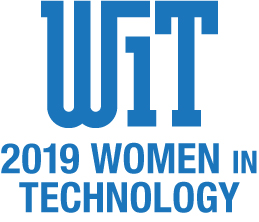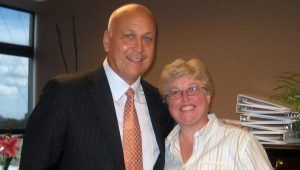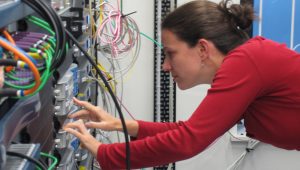
Deb Grivois, Katy Noland and Larissa Gӧrner are this year’s winners of TVNewsCheck’s annual Technology Women to Watch Awards that will be presented during the NAB Show on April 9 in Las Vegas.

Deb Grivois, Katy Noland and Larissa Gӧrner are this year’s winners of TVNewsCheck’s annual Technology Women to Watch Awards that will be presented during the NAB Show on April 9 in Las Vegas.
 For the past eight years, TVNewsCheck has presented its Women in Technology awards to individuals who are established leaders at the forefront of broadcast technology as well as promising up-and-coming members of the engineering community.
For the past eight years, TVNewsCheck has presented its Women in Technology awards to individuals who are established leaders at the forefront of broadcast technology as well as promising up-and-coming members of the engineering community.
The Technology Women to Watch Awards shine a spotlight on women in media and entertainment who show significant promise of advancing their industry. And this year the number of honorees has been expanded from two to three.
The awards support the National Association of Broadcasters Education Foundation’s Technology Apprenticeship Program, which places graduating engineers who are women or people of color in broadcast industry internships. The program has helped scores of participants to find industry jobs.
The 2019 Technology Women to Watch:

Deb Grivois with baseball legend Cal Ripkin Jr. during her days at WBAL Baltimore.
Deb Grivois is director of engineering for Hearst Television’s NBC affiliate WLWT Cincinnati. Over her career that’s spanned more than 30 years, she’s been involved in planning, building and operating television facilities. And now she’s very committed to passing along her passion for the work to students.
She caught the media bug in high school. Two of her English teachers got her interested in the school paper (“they installed a love of words into me”) and the paper’s adviser continued her indoctrination into journalism. That led her to Ohio State and a journalism major where, she says, “once I was exposed to the broadcast side, it was all over.”
While in school she had two internships at the Outlet Co.’s NBC affiliate WCMH Columbus, Ohio. “The first one was at PM Magazine and that was basically stuffing envelopes and making phone calls. My second one was in the news department, which was pretty much beat calls at the assignment desk, you are answering the phones and making phone calls to the various police and fire dispatchers, find out what was going on. But I was able to get out in the field with a photographer who put me onto this vacation relief opportunity in the summer and so I applied for that and got that job.”
When that was about over, the station had some unexpected vacancies to fill so they kept her on and hired her after her graduation in 1981. “Then I got hired as a full-time operator and then was promoted to a full-time engineer and then I went to operation supervisor, then I went to operations manager.”
In 1993 she was sent to co-owned WJAR Providence, R.I., to be director of station operations. After three years, she was moved back to WCMH to be director of operations and engineering and shortly afterwards the station was bought by NBC. “I started doing some traveling with NBC, going to conferences and for DTV [transition] planning.
“Then NBC sold many of the original Outlet stations to Media General in 1996 and then Media General sold the [operational] hub in Tampa, Fla. I convinced [Media General’s] Ardell Hill that Columbus was the place to be because we didn’t have hurricanes.” So she worked on NBC’s three operational hubs and guided the DTV buildout at two sister stations while also overseeing the DTV conversion at WCMH. “I also managed and implemented WCMH’s satellite studio in downtown Columbus and its HD production control room.”
Her next move was to Hearst Television’s NBC affiliate WBAL Baltimore in 2011 as engineering manager. With strong ties to Ohio where she has family, she moved to Hearst’s WLWT Cincinnati in 2015.
And she’s plenty busy. “The spectrum repack is the number-one project that we have going. As you know, that is a multiyear project for most TV stations and we are about ready to install our transmitter. We started with the tower work last fall and we will be completing that this summer. So that will also include installing two new antennas, one auxiliary and one main, which will be the bottom of a stacked antenna.”
While at WBAL, she was impressed by an apprentice they had from the NAB Education Foundation technology apprenticeship program (TAP). “At WLWT, I reached out to NABEF looking for a possible TAP intern and that’s how I became a team member to review applicants for TAP for its 2018 group.”
She also is mentoring her second protégé with American Corporate Partners, a group that helps former military personnel transition into civilian jobs. “I take someone’s resumé and work with them to translate it into the corporate lingo. The person I was mentoring last year, the timing just hit at the right time with the right opportunity where his skill set was needed at one of our stations in South Carolina, and I was able to help get him an interview — and he now works there.”
Grivois also is looking to get more young people interested in broadcasting, working with the local Warren County Career Center. “We don’t get many intern applications and so we have been doing some reaching out to colleges and high schools to get young people who are kind of interested in television, but don’t really know what they want to do, and steer them toward the technical side, whether they be fixers or operators. If we can get interns here early in their college careers, we can guide them into this type of job and subsequently a career. And so that’s one of the things that I wanted to do and I especially want to, as a woman, try to gain that interest in young ladies who are trying to pursue a career in technology.”
That technology thing sure worked for Deb Grivois.

Katy Noland taking a hands-on approach.
At England’s University of Surrey, Katy Noland cultivated a life-long interest in music, which led to a desire to learn about sound recording. “That got me interested in media more generally and the … more technical side of it, the signal processing side of it, which is something that’s been with me through my whole career since then.”
After graduating in 2003, she went on to receive a Master of Science in digital signal processing from Queen Mary University of London, and joined the Centre for Digital Music there to study for a Ph.D. in automatic analysis of tonal harmony, which she was awarded in 2009.
In 2006 she also became a teaching fellow in the Department of Electronic Engineering at Queen Mary, teaching audio and video signal processing. After six months as a visiting researcher at Sony in Tokyo, Noland joined BBC Research and Development in 2011 and it’s there that she started working professionally with video, particularly high dynamic range video (HDR).
“I joined a team who were interested in video processing generally. My first project was looking at interlacing. Then after that I joined a team who were looking at standardizations of ultra-high definition [UHD] and did a lot of work looking at the limits of human motion perception with applications in high frame-rate TV, and then I have been involved in the development of the hybrid log gamma [HLG] system for high dynamic range.”
Noland’s research focuses on how the human eye processes UHD and HDR video, and she’s co-authored or published a number of papers on the subject. She also received the 2017 SMPTE Journal Certificate of Merit for her paper on high frame-rate television.
Determining the quality of these media is complicated, to say the least. “We do a lot of work with live subjects. The only really reliable way of assessing the quality of media is really to use people. There are various methods of measuring quality objectively, but none of them really quite capture the full complexity of the human brain.”
Noland is also working on developing a meter to measure the perceived brightness of HDR video. “We are looking at developing an effective meter that will correspond to the human impression of video brightness to try to control and to make sure there is some consistency between different programs,” sort of the video version of traditional TV’s longstanding audio loudness issues.
“It’s only now becoming a potential problem as screens get brighter and we have got this signal format that can transmit a wider contrast range.”
In addition to this cutting-edge research, she’s also part of the BBC involvement in various standards bodies. “I attend the ITU [International Telecommunication Union] meetings … working on the brightness meter and also on the whole production system for HDR.”
In the short term, she says, the challenge is “getting the industry comfortable with HDR production. Slightly more longer-term, I think there is going to be some work needed on higher frame rates just to understand whether we need them, what benefits they bring, how to produce in high frame rates and so on.
“And much more longer-term, there are all sorts of sort of new types of content experiences on the horizon. It is going to be a huge challenge to work out how to actually make these systems work.”

Larissa Görner is equally at home in front of or behind a camera.
Ever since college, Larissa Görner was not one to limit herself to one field of study or a narrow career path. Instead she worked on — and at — what interested and attracted her. And that ranged from business administration and engineering to television to sports.
Görner has demonstrated excellence in remote productions, including the Olympics, and she has done distinguished work in product development and consulting. She holds board appointments with AIMS (the Alliance for IP Media Services) and FKTG, Germany’s society for motion picture and television engineers.
After she graduated in Germany with degrees in media design and electrical engineering (undergraduate) in 2005, Gӧrner got “an internship in a TV production company. We were doing live SNG, news and sports coverage.”
And after that she went to work as a freelancer for German broadcaster ARD in Rome. “I was working as an SNG operator … doing newsgathering and editing, mostly for news.”
She decided she needed to go back to Germany to go to school “to get a deeper insight into what I was working on. I didn’t just want to do this, I also just wanted to understand what I’m doing. So I went back and started studying electrical engineering and communications.”
On the weekends, she was working for the German soccer league Bundesliga, “so I think I know every stadium in Europe. It was really a great experience. And then I got my [MBA] degree in electrical engineering and I started to work for the IRT, which is the research institute of the German public broadcasters,” as a research engineer and television production assistant.
At the same time, Görner was still “doing a little football here and there” on the side. “I love sports, especially I love soccer. I like a lot of the winter sports as well.”
At IRT, she was working on standardized subtitling and then was promoted to general manager of contracted research, “more like marketing and sales of all the products that they didn’t develop at IRT, selling those through the industry to broadcasters.”
About a year later, in 2013, she moved to Belgium to be with her partner and joined a startup, SDNsquare, that provided SDN (software defined networking) solutions. As head of product marketing and sales, Görner was involved in a variety of projects, including early work on transitioning to IP.
A year later, she was hired as a sales consultant by the Swedish company Net Insight that was developing new products and services including remote production and service orchestration. After a while in sales, she says, “I missed the really technical part” and was able to become a strategic product manager.
Görner got on “the really great team where at that time, the first IP applications were done not only in the transport side, but then in the streaming side.” That was in 2016. In 2018, Net Insight moved her into the CTO office, developing solutions and products with a major focus on WAN applications, including distributed production and cloud production, as well as remote production.
An early user for the remote production technology has been sports, she says. It allows a broadcaster to have only the acquisition at a venue — the cameras, the audio — but doing everything else — the video mixing, replays, audio, highlights, etc. — from a remote location.
“Everybody is looking on how can we produce more efficiently. That has been kind of like the core of my work. I hope to always make this broadcast industry more efficient, make it better.”
Görner sees IP as a “necessary step” in the industry’s advancement. “I think we are kind of like the last industry that has more or less not [transitioned to IP] and it is still going to take a while. Broadcast has always been very special and adoption [of new tech] always comes when the need is there, and I think now, with all this mass of content, with having cloud infrastructures, it just makes so much sense.”
A big challenge to broadcasting, she says, is producing different content and making it accessible to young people who have entirely different viewing habits. “I hope that this great machine of broadcast … will make that move happen. I think that is going to be the focus for me until I retire.”
Her next move is coming shortly, Görner says. “After four-and-a-half very exciting years at Net Insight in Sweden, I left the company end of February to seek new adventures. Net Insight is a fantastic company and I learned so many things from my colleagues and friends about transport, IP, live contribution and the how to enable a connected media landscape around the globe. We definitely brought at-home production to the next level, which will enable even more companies in the future to produce more efficiently. I want to say thank you to my colleagues and am now ready for my next challenge in my beloved media industry to enable continuous innovation in our business towards the next generation of content viewers.”
Comments (0)